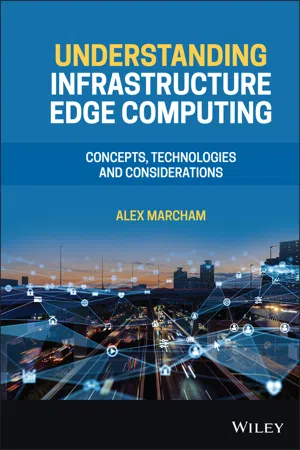
Understanding Infrastructure Edge Computing
Concepts, Technologies, and Considerations
- English
- ePUB (mobile friendly)
- Available on iOS & Android
About this book
UNDERSTANDING INFRASTRUCTURE EDGE COMPUTING
A comprehensive review of the key emerging technologies that will directly impact areas of computer technology over the next five years
Infrastructure edge computing is the model of data center and network infrastructure deployment which distributes a large number of physically small data centers around an area to deliver better performance and to enable new economical applications. It is vital for those operating at business or technical levels to be positioned to capitalize on the changes that will occur as a result of infrastructure edge computing.
This book provides a thorough understanding of the growth of internet infrastructure from its inception to the emergence of infrastructure edge computing. Author Alex Marcham, an acknowledged leader in the field who coined the term 'infrastructure edge computing, ' presents an accessible, accurate, and expansive view of the next generation of internet infrastructure. The book features illustrative examples of 5G mobile cellular networks, city-scale AI systems, self-driving cars, drones, industrial robots, and more—technologies that increase efficiency, save time and money, and improve safety. Covering state-of-the-art topics, this timely and authoritative book:
- Presents a clear and accurate survey of the key emerging technologies that will impact data centers, 5G networks, artificial intelligence and cyber-physical systems, and other areas of computer technology
- Explores how and why Internet infrastructure has evolved to where it stands today and where it needs to be in the near future
- Covers a wide range of topics including distributed application workload operation, infrastructure and application security, and related technologies such as multi-access edge computing (MEC) and fog computing
- Provides numerous use cases and examples of real-world applications which depend upon underlying edge infrastructure
Written for Information Technology practitioners, computer technology practitioners, and students, Understanding Infrastructure Edge Computing is essential reading for those looking to benefit from the coming changes in computer technology.
Frequently asked questions
- Essential is ideal for learners and professionals who enjoy exploring a wide range of subjects. Access the Essential Library with 800,000+ trusted titles and best-sellers across business, personal growth, and the humanities. Includes unlimited reading time and Standard Read Aloud voice.
- Complete: Perfect for advanced learners and researchers needing full, unrestricted access. Unlock 1.4M+ books across hundreds of subjects, including academic and specialized titles. The Complete Plan also includes advanced features like Premium Read Aloud and Research Assistant.
Please note we cannot support devices running on iOS 13 and Android 7 or earlier. Learn more about using the app.
Information
1
Introduction
2
What Is Edge Computing?
2.1 Overview
2.2 Defining the Terminology
2.3 Where Is the Edge?
2.3.1 A Tale of Many Edges
Table of contents
- Cover
- Table of Contents
- Title Page
- Copyright Page
- Dedication Page
- Preface
- About the Author
- Acknowledgements
- 1 Introduction
- 2 What Is Edge Computing?
- 3 Introduction to Network Technology
- 4 Introduction to Data Centre Technology
- 5 Infrastructure Edge Computing Networks
- 6 Infrastructure Edge Data Centres
- 7 Interconnection and Edge Exchange
- 8 Infrastructure Edge Computing Deployment
- 9 Computing Systems at the Infrastructure Edge
- 10 Multi‐tier Device, Data Centre, and Network Resources
- 11 Distributed Application Workload Operation
- 12 Infrastructure and Application Security
- 13 Related Technologies
- 14 Use Case Example
- 15 Use Case Example
- 16 Use Case Example
- 17 Use Case Example
- 18 Other Infrastructure Edge Computing Use Cases
- 19 End to End
- 20 The Future of Infrastructure Edge Computing
- 21 Conclusion
- Appendix A: Acronyms and Abbreviations
- Index
- End User License Agreement